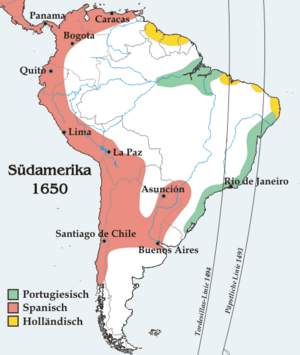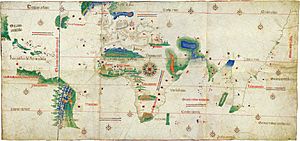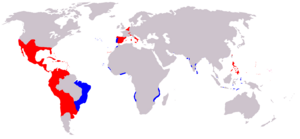Inter caetera facts for kids

Inter caetera (which means 'Among other [works]') was a special letter from Pope Alexander VI. He issued it on May 4, 1493. This letter gave King Ferdinand II of Aragon and Queen Isabella I of Castile of Spain all lands to the "west and south." These lands were located 100 leagues west and south of the Azores or Cape Verde islands.
It's not fully clear if the Pope meant to give Spain full ownership of these lands. Some people thought it just made their claim to the land legal. Others, like the Spanish rulers and explorers (called conquistadors), believed it gave Spain complete control.
Inter caetera and another letter called Dudum siquidem (from September 1493) are known as "Bulls of Donation." These letters tried to solve arguments between Spain and Portugal. However, they did not consider other countries' plans for exploration and colonization. This became a bigger problem after the Protestant Reformation.
Contents
How It Started
Before Christopher Columbus got help from Spain, he first asked King John II of Portugal. The King's experts looked at Columbus's plans. They decided his math was wrong and that the trip would be much longer. So, they said no to funding his journey.
When Columbus returned from his first trip to the Americas, he first landed in the Portuguese Azores. A storm then pushed his ship to Lisbon on March 4, 1493. When King John heard about Columbus's discoveries, he told Columbus that his trip might have broken the 1479 Treaty of Alcáçovas. This treaty had been approved by a papal letter in 1481 called Aeterni regis. That letter confirmed earlier ones from 1452, 1455, and 1456. These letters recognized Portugal's claims along the West African coast. The King of Portugal thought the treaty meant Portugal owned all land south of the Canary Islands (which belonged to Spain).
Columbus's arrival in lands he thought were in Asia, but were actually in the Americas, caused problems between Portugal and Spain. When Spain heard that King John was getting a fleet ready to sail west, the Spanish King and Queen started talks. They wanted to discuss who had the right to own and rule the new lands. Spanish and Portuguese representatives met from April to November 1493. But they could not agree.
Columbus was still in Lisbon when he sent a report of his success to the Spanish rulers. On April 11, the Spanish ambassador told Pope Alexander VI the news. The Pope was from Spain and was friendly with King Ferdinand and Queen Isabella. He quickly issued new letters that favored Spain. The Pope issued letters on May 3 and 4, 1493. The third letter replaced the first two. A final letter, Dudum siquidem, on September 26, 1493, added more to Inter caetera.
- The first letter, Inter caetera, dated May 3, said Spain could claim any newly found lands. This was true as long as no other Christian ruler already owned them. It also protected Portugal's existing rights. Both countries found this letter too unclear.
- The second letter, Eximiae devotionis, also dated May 3, gave the kings of Castile and León the same rights in the new lands. These were the same rights that Portugal's kings had in Africa and Guinea.
- The third letter, also called Inter caetera, dated May 4, told the Spanish rulers to spread the Christian faith west. It set a line "one hundred leagues towards the west and south" from the Azores and Cape Verde islands. Some people think Portugal's ambassador asked for this change.
The Inter caetera letter and the later Treaty of Tordesillas set up a zone for Spain. Portugal was not allowed in this zone. For other countries, this agreement had no legal power. Spain tried to convince other European powers that Inter caetera was legal. But they never succeeded.
What the Letter Said
Inter caetera stated:
Among other works well pleasing to the Divine Majesty and cherished of our heart, this assuredly ranks highest, that in our times especially the Catholic faith and the Christian religion be exalted and be everywhere increased and spread, that the health of souls be cared for and that barbarous nations be overthrown and brought to the faith itself. ...[W]e ... assign to you and your heirs and successors, kings of Castile and Leon, ... all islands and mainlands found and to be found, discovered and to be discovered towards the west and south, by drawing and establishing a line from ... the north, ...to ...the south, ... the said line to be distant one hundred leagues towards the west and south from any of the islands commonly known as the Azores and Cape Verde.
The letter mentioned that Isabella and Ferdinand "had intended to seek out and discover certain islands and mainlands remote and unknown." But they had been busy with the conquest of Granada.
The dividing line only split the Atlantic Ocean areas. Spain and Portugal could pass each other on the other side of the world. They could still claim any lands they found first there. The letter did not say if lands east of the line would belong to Portugal. Portugal had only recently reached the southern tip of Africa (1488). They had not yet reached India (1498). These lands "to be discovered" were beyond those along the west coast of Africa. They were given to Portugal by the 1481 letter Aeterni regis. This letter had approved the Treaty of Alcáçovas. For a while, the question of these lands was put on hold.
What Happened Next
An important but unexpected result of this papal letter and the Treaty of Tordesillas was that almost all of the Pacific Ocean was given to Spain. This also included the west coast of North America.
King John II of Portugal did not try to argue with Rome. He simply ignored the Pope's letters. He did not accept their power, but he also did not openly challenge the Church. Portugal controlled the sea routes from Spain to the Antilles. It also had bases in the Azores and Madeira. Portugal was in a strong naval position. So, King John chose to negotiate directly with Spain.
Neither Spain nor Portugal paid much attention to Pope Alexander's letters. Instead, they negotiated the 1494 Treaty of Tordesillas. This treaty moved the dividing line further west. It was now 370 leagues west of the Portuguese Cape Verde Islands. This new line clearly gave Portugal all newly discovered lands east of the line.
In 1512, Portugal discovered the Spice Islands. In response, Spain suggested in 1518 that Pope Alexander had divided the world into two halves. By this time, however, other European countries had mostly rejected the idea. They did not believe the Pope had the right to give away huge areas like the New World. Even in Spain, important people like Francisco de Vitoria said Inter caetera was not valid. Spain never gave up its claims based on papal letters. But the Spanish rulers also did not ask the Pope to enforce the Atlantic dividing line. Instead, Spain negotiated directly with Portugal.
Piis fidelium
On June 25, 1493, King Ferdinand got another papal letter, Piis fidelium. This letter made him a special church representative in the Indies. Father Bernardo Buil traveled from Cádiz to America on September 25, 1493. He was part of Columbus's second expedition. Once on the island of Hispaniola, Buil saw how the conquistadors treated the colonists and Native Americans. He argued with Columbus about this harsh treatment. Buil saw that it was impossible to spread the Christian faith there. So, he returned to Spain within six months, on December 3, 1494. Two other friars he had left in the Americas returned to Spain in 1499.
Lasting Impact
This religious permission to take lands from non-Christian peoples was mentioned much later. U.S. Chief Justice John Marshall used it almost 300 years later. He was developing the discovery doctrine in international law.
In the 21st century, groups like the Shawnee, Lenape, Taíno, and Kanaka Maoli have protested. They have asked to cancel the papal letter Inter caetera. They want to remind Catholic leaders about the history of conquest, disease, and slavery in the Americas. These actions were sometimes justified in the name of Christianity. These groups say this history still harms their cultures today.
See also
 In Spanish: Bula menor Inter caetera de 1493 para niños
In Spanish: Bula menor Inter caetera de 1493 para niños
- Catholic Church and the Age of Discovery
- Portuguese colonization of the Americas
- Treaty of Zaragoza



